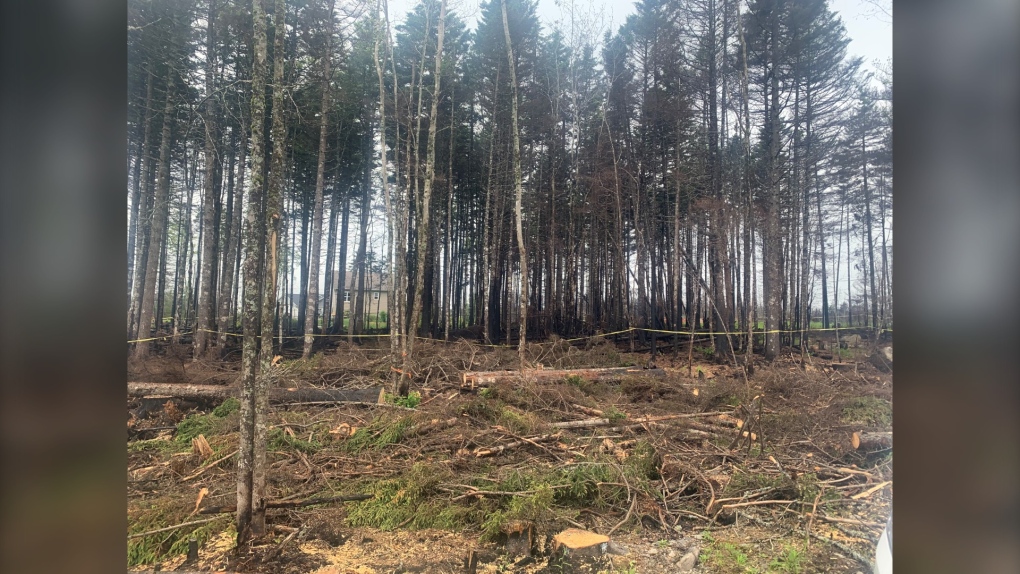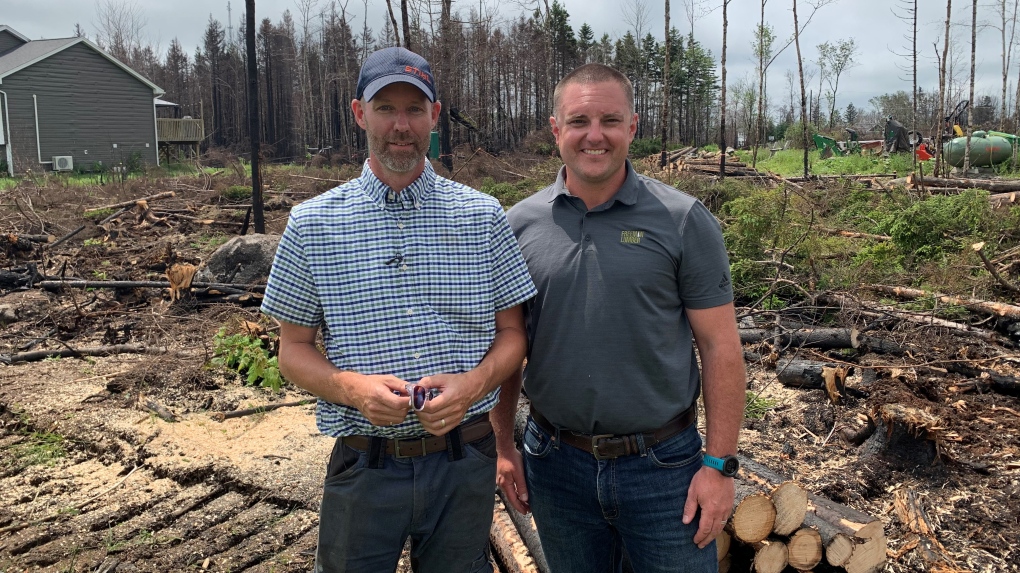What's happening to the many trees charred by the N.S. wildfire?
Behind a home in the Halifax-area subdivision of Perry Pond, the operator of a harvesting machine called a “feller buncher” is carefully clearing trees left charred by late May’s devastating wildfire.
“He's going to cut the dead, burned spruce trees and lay them on the side,” explains forester Matt Willett.
 A wood processor at work in Hammonds Plains, Nova Scotia. (Courtesy: Matt Willett)
A wood processor at work in Hammonds Plains, Nova Scotia. (Courtesy: Matt Willett)
The wildfire hit the Hammonds Plains and Upper Tantallon areas hard, burning about 950 hectares and destroying 151 homes.
“I used to live in the area. I’m a volunteer firefighter in the area, and I was at the fire, fought the fire,” says Willett. “Being a forester and a firefighter gave me a unique perspective.”
Trained in forestry at the University of New Brunswick, Willett has worked in the industry for several decades and is now the director of operations and business development for Wagner Forest Nova Scotia.
Once the fire was contained, Willett got to work to see if he could help and started canvassing communities to see which homeowners would be interested in having burned woods cleared, free of charge.
 Charred wood left behind in the aftermath of the wildfire that burned in the Hammonds Plains area in late May. (Heidi Petracek/CTV Atlantic)
Charred wood left behind in the aftermath of the wildfire that burned in the Hammonds Plains area in late May. (Heidi Petracek/CTV Atlantic)
As a result, a team of workers has been busy in both Westwood Hills and Perry Pond.
“It’s 20 individual projects, consolidated into one because each residential property is almost a project unto itself,” he explains.
“And that gave it the economy of scale that I could do what I had hoped to - which was to do the job at no cost to the landowner,” he adds.
Willett says many residents told him they had received quotes for the work totalling tens of thousands of dollars, many who told him it was not covered by their insurance.
Willett recruited other forestry-related contractors to help with the removal effort as well- Reeves Logging and Tree Farms and N.R. Kenny Logging.
But the question became: what to do with all the wood?
That’s where Marcus Zwicker, fellow UNB alumni and chief operating officer of Greenfield-based sawmill Freeman Lumber, came in.
 Matt Willett, forester and director of operations for Wagner Forest NS (left) and Marcus Zwicker (right), chief operating officer of Freeman Lumber. (Heidi Petracek/CTV Atlantic)
Matt Willett, forester and director of operations for Wagner Forest NS (left) and Marcus Zwicker (right), chief operating officer of Freeman Lumber. (Heidi Petracek/CTV Atlantic)
“This is sort of a new thing in here in Nova Scotia, sawing burnt wood. Hopefully, it’s not going to be something that happens on a regular basis,” says Zwicker.
But sawmills in Western Canada have done it before, so Zwicker started by making a few phone calls for advice.
“We had to make some modifications and work on some different things to address the look of the lumber,” he explains. “Because most owners don’t want to buy lumber that’s black or charred.”
The forest fire burned so fast that many trees were only blackened on the outside surface.
 Charred wood left behind in the aftermath of the wildfire that burned in the Hammonds Plains area in late May. (Heidi Petracek/CTV Atlantic)
Charred wood left behind in the aftermath of the wildfire that burned in the Hammonds Plains area in late May. (Heidi Petracek/CTV Atlantic)
Zwicker says Freeman Lumber uses technology powered by artificial intelligence to detect common lumber flaws such as stains or holes.
They trained it to detect charring also, so those logs could be automatically diverted for extra processing until the wood comes out completely clean.
“We tried three loads last week, and we called Matt back and told him we were pretty confident we could continue with the job, (and) turn it into lumber that Nova Scotians can hopefully purchase at a hardware store near you,” he says.
“The sawdust and shavings will get used … to sell at local co-ops for animal bedding,” he adds. “We also sell the sawdust to a pellet mill in Musquodoboit.”
“The bark and the chips are used primarily for the Emera plant in Liverpool, Brooklyn Energy, to generate electricity for the grid,” Zwicker explains.
 Charred wood from the Tantallon wildfire that is about to be processed. (Heidi Petracek/CTV Atlantic)
Charred wood from the Tantallon wildfire that is about to be processed. (Heidi Petracek/CTV Atlantic)
For the president of the Westwood Hills Residents Association, the work is helping residents deal with the overwhelming aftermath of the fire.
“We wanted to try and do something to provide some alleviation of the stress that causes to people who have already been under a ton of stress,” says Dustin O’Leary.
“We can’t forget that we also have hurricane season still to come, and winter, where you have snow that will add weight to trees that have been impacted by fire, so we needed to clear that out,” he says.
“This is a really great example of how community, people who care, work together to do something big,” O’Leary adds.
“It's a healing process as well, these are their homes,” says Willett.
Willett says the work will continue for several more weeks. He’s also hoping to assist residents in Highland Park, which was also affected by the fire, although he says details remain to be worked out.
In the end, he hopes the work will ultimately help communities recover and rebuild, much like it helps the woods to do the same.
For the latest Nova Scotia news, visit our dedicated provincial page.
CTVNews.ca Top Stories

Can the Governor General do what Pierre Poilievre is asking? This expert says no
A historically difficult week for Prime Minister Justin Trudeau and his Liberal government ended with a renewed push from Conservative Leader Pierre Poilievre to topple this government – this time in the form a letter to the Governor General.
'I'm still thinking pinch me': lost puppy reunited with family after five years
After almost five years of searching and never giving up hope, the Tuffin family received the best Christmas gift they could have hoped for: being reunited with their long-lost puppy.
Two U.S. Navy pilots shot down over Red Sea in apparent 'friendly fire' incident, U.S. military says
Two U.S. Navy pilots were shot down Sunday over the Red Sea in an apparent 'friendly fire' incident, the U.S military said, marking the most serious incident to threaten troops in over a year of America targeting Yemen's Houthi rebels.
Big splash: Halifax mermaid waves goodbye after 16 years
Halifax's Raina the Mermaid is closing her business after 16 years in the Maritimes.
OPP find wanted man by chance in eastern Ontario home, seize $50K worth of drugs
A wanted eastern Ontario man was found with $50,000 worth of drugs and cash on him in a home in Bancroft, Ont. on Friday morning, according to the Ontario Provincial Police (OPP).
Bluesky finds with growth comes growing pains - and bots
Bluesky has seen its user base soar since the U.S. presidential election, boosted by people seeking refuge from Elon Musk's X, which they view as increasingly leaning too far to the right given its owner's support of U.S. president-elect Donald Trump, or wanting an alternative to Meta's Threads and its algorithms.
B.C. mayor gets calls from across Canada about 'crazy' plan to recruit doctors
A British Columbia community's "out-of-the-box" plan to ease its family doctor shortage by hiring physicians as city employees is sparking interest from across Canada, says Colwood Mayor Doug Kobayashi.
It was Grandma, in the cafe with a Scrabble tile: Game cafes are big holiday business
It’s the holidays, which means for many across the Prairies, there’s no better time to get locked in a dungeon with a dragon.
Cancer centre raises $2.7 million for purchase of 'game changer' surgical robot
The Windsor Cancer Centre Foundation has raised a record breaking $2.7 million through the Grow on Windsor Campaign.































